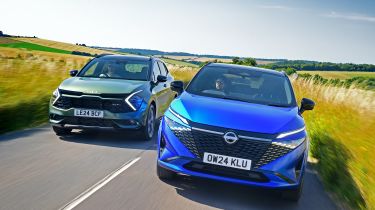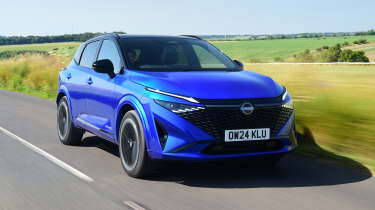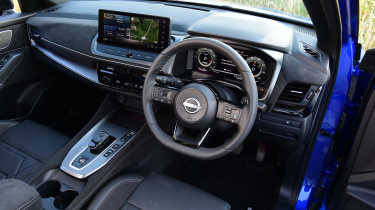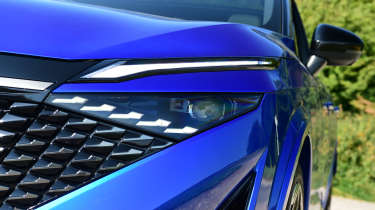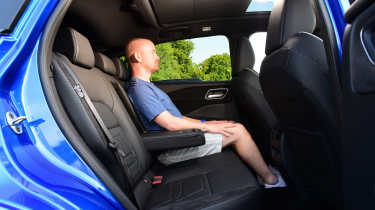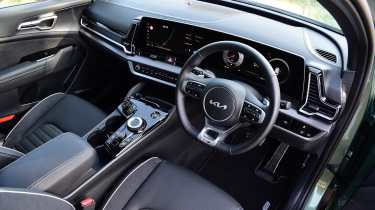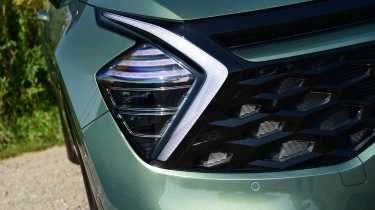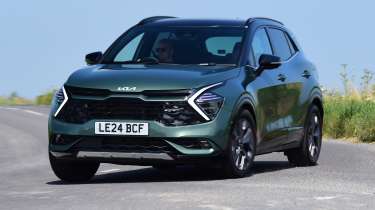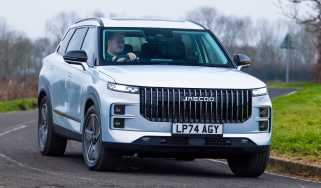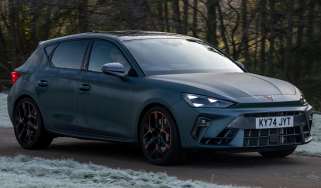Nissan Qashqai vs Kia Sportage: top hybrid SUVs go head-to-head
Nissan’s Qashqai once ruled the crossover kingdom, but lost its crown to rivals such as the Kia Sportage. Can the new version regain the throne?
Back in the mid-2000s, Nissan was an also-ran in the family-car segment. Realising that its worthy-but-dull Almera hatchback couldn’t compete directly with the established competition in the class, the manufacturer tried a different approach.
The result was the Nissan Qashqai, a car with the driving manners and price of a regular hatchback, but the kerb appeal and space of a larger SUV. The move proved to be a masterstroke for Nissan, with the Qashqai immediately becoming a sales superstar.
And even though rivals had caught up by the time the third-generation car arrived, it remains a huge success with customers. In 2024 to date, it’s the third best-selling new car in the UK; only the smaller Ford Puma and one other car have been more successful.
Here the Nissan faces that second model. The Kia Sportage follows the formula that the Qashqai devised, and in some ways has improved on it. In recent times, the Korean manufacturer has had the upper hand.
Now, however, there’s a newly revised Nissan Qashqai. So how deep do its updates go, and will they be enough to swap the running order in the sales charts, and even reverse the order for the overall win in this test?
| Nissan Qashqai | Kia Sportage | |
| Price: | £39,620 | £40,690 |
| Powertrain: | 1.5-litre 3cyl turbo HEV, 187bhp, front-wheel drive | 1.6-litre 4cyl turbo HEV, 212bhp, front-wheel drive |
| 0-62mph: | 7.9 seconds | 8.4 seconds |
| Test efficiency: | 45.6mpg/10.0mpl | 44.3mpg/9.7mpl |
| CO2: | 117g/km | 132g/km |
| Annual VED: | £180 | £590 |
Nissan Qashqai
Among the changes to the Qashqai line-up is a revamped trim structure, which includes the new N-Design model that we’re driving here. It costs £39,620 in e-Power hybrid form.
Tech highlights
Not much has changed on the technical side, but then the Qashqai already had one of the most intriguing powertrain options in its class. The e-Power hybrid system mixes a petrol engine with an electric motor; so far, so conventional.
Used - available now

2022 Nissan
Qashqai
35,024 milesManualPetrol1.3L
Cash £19,429
2022 Nissan
Qashqai
21,298 milesManualPetrol1.3L
Cash £16,518
2017 Nissan
Qashqai
62,692 milesManualDiesel1.5L
Cash £9,799
2022 Nissan
Qashqai
24,141 milesManualPetrol1.3L
Cash £16,237The Qashqai’s clever trick is that the petrol engine never directly drives the front wheels. Instead it works as a generator, which sends energy to a 187bhp electric motor via a compact 2.1kWh battery. The benefit of this, Nissan says, is that drivers get the instantaneous response of an electric car but with the flexibility – including the ease of refuelling – of a petrol-powered one.
In other ways, the Qashqai is similar to other hybrids; it can, for example, drive in full-EV mode for short distances, and regenerative braking also contributes towards keeping the battery topped up. The strength of this can be increased by using an ‘e-pedal’ button on the centre console.
Safety: The Qashqai was assessed by Euro NCAP in 2021 and was awarded the maximum five-star rating. Scores of 91 per cent for Child Occupant protection and a 95 per cent rating in the Driver Assist category were the highest of any car tested that year, while the Adult Occupant result of 91 per cent was also among the best recorded in 2021.
Safety tech is largely unchanged in this facelift, but the 360-degree parking-camera monitoring system has been improved. It now has a digital representation of the car on-screen and a setting that allows users to ‘see through’ the bonnet on screen to spot obstacles and kerbs more easily.
On the road
The latest Nissan Qashqai drives much as it did before; so while it isn’t outstanding in any one area, the model doesn’t have any glaring flaws either.
Around town: Nissan reckons that the Qashqai e-Power feels like an EV to drive, and we agree. It’s most obvious at low speeds, when the throttle response is lively and nearly instantaneous; there’s none of the dithering you get from a regular petrol-powered car equipped with an automatic gearbox. The right pedal is also easy to modulate.
A & B-roads: Fun is a quality that’s quite a long way down the Qashqai’s virtue list, but we don’t really care about that in a car such as this. What matters is that it’s stable and secure for the most part, agile enough when it needs to be, and the steering – although not loaded with feedback – is positive and precise enough.
When the powertrain is called into action to perform an overtake, the energy is there after only a brief pause while the petrol engine perks up to deliver everything it’s got to the electrical system.
The suspension isn’t the softest in this class – and we’d perhaps like the springs and dampers to provide just a little more give – but it’s by no means harsh, and for the most part the Qashqai does a competent job of smoothing out the worst road imperfections. In short, everything is good without topping the class in any one area.
Motorway: Nissan says that the updated Qashqai gets more sound deadening than its predecessor. While we haven’t compared them side by side, the new car is hushed at speed. Engine noise is there under hard acceleration, but it’s not intrusive, and at higher speeds, road noise is well contained. High-speed comfort and stability are also great.
Ownership
The changes inside are a little more understated and mainly focus on improving perceived quality. In our test car, this involves trimming part of the seats and a large section of the dash in Alcantara. This breaks up what was previously plastic – or plastic imitating leather, depending on the model.
Elsewhere, it’s largely the same as before; it’s not the most dramatic design to look at, but the finish is solid, the layout is fairly logical and there’s plenty of adjustment possible in the driving position. Nissan has struck a decent balance between touchscreen keys and physical buttons, with the latter used for the air-conditioning functions, which is a big plus point in our book.
The N-Design trim features a panoramic sunroof. It’s certainly a luxury item, but its sheer size also makes it a great feature because it can let a huge amount of light into the cabin.
Nissan finished 15th out of 32 brands in the 2024 Driver Power customer-satisfaction survey. That’s a reasonable improvement on the 19th-place result it took in 2023, and with 18.2 per cent of owners experiencing a fault of some sort, that’s a small reduction on the 19 per cent of the previous year. To put that figure into perspective, Toyota, a brand that is famed for its reliability, achieved a score of 18.1 per cent, while 24.3 per cent of Kia owners experienced issues of some sort.
Storage: A compact gear selector frees up space for a couple of deep cup-holders in the Qashqai’s centre console, while stowage elsewhere in the cabin is also impressive. The storage area under the central armrest is large, the door bins are wide and deep, and the glovebox is okay, too.
A large smartphone tray can hold even the bulkiest devices and offers wireless charging. Further back, there’s quite a sizeable storage space beneath a reversible boot floor, but it’s spoiled by a hump in the centre of the area.
Practicality
The Nissan isn’t the most spacious car in its class, but it’s a reasonable compromise considering that the SUV is also physically smaller than many of its competitors.
Rear space: Most families will be perfectly happy with the space on offer inside. Kneeroom is generous, and headroom, although not class leading, is par for the course among C-segment hatchbacks and SUVs. Only a high floor compromises under-thigh support. One standout feature here is that the Qashqai’s doors open to almost a complete right angle, which makes access easy. That’s very handy when installing a child seat or loading other bulky luggage.
Boot: It’s here where the Nissan falls furthest short of its most roomy SUV rivals. But at 479 litres, the space on offer is still comfortably bigger than in the vast majority of traditional family hatchbacks.
What to buy?
Which engine and trim we’d choose
- Engines: Below the e-Power hybrid in the range is a mild-hybrid petrol car. A 138bhp version of the 1.3-litre turbo is only available with a manual gearbox, while a 156bhp variant is offered with a choice of manual and an unpleasant CVT automatic. The auto version is optionally available with four-wheel drive, too.
- Trim: There are five trim levels to choose from: Acenta Premium, N-Connecta, N-Design, Tekna and Tekna+. While the new N-Design gets luxuries such as a panoramic roof, the N-Connecta goes without them and has a simpler rear suspension, but costs £3,020 less.
- Our choice: N-Connecta has more than enough kit for most buyers at a competitive price.
Kia Sportage
The GT-Line S is the peak of the Kia Sportage range, and that’s the model we’re testing here. At £40,690 for the Hybrid model, it’s £1,070 more expensive than the Qashqai that we’re evaluating.
Tech highlights
Kia’s approach to the hybrid system is more conventional than its rival’s. Here, a 1.6-litre turbocharged petrol engine does most of the legwork, but for gentle throttle openings and when coasting, the four-cylinder unit can shut down and hand responsibility over to a 59bhp electric motor. The 1.5kWh battery isn’t as large as the Nissan’s, but much like its competitor, it allows electric-only driving for short distances.
Unlike plug-in hybrids, which carry a hefty battery around that when flat labours the petrol engine, the Sportage Hybrid’s battery is much more compact; it weighs only 37.5kg and is installed under the SUV’s back seats.
In total, the full system output is 212bhp and 350Nm of torque, which gives the Kia a 25bhp and 20Nm advantage over its British-built rival. While the Nissan uses a single-speed drive unit for its electric motor, the Kia’s torque is sent through a six-speed dual-clutch automatic gearbox.
Buyers can choose the hybrid powertrain with front or four-wheel drive. The latter is less frugal and marginally slower, with a 0-62mph time of 8.7 seconds versus 8.4 for the front-driven option. For most buyers, we think front-drive makes most sense.
Safety: A five-star rating was awarded to the Kia Sportage when it was tested by Euro NCAP in 2022. A blind-spot warning system is standard on the GT-Line S but is unavailable on other trim levels. This spec also gets a remote-parking system, which can roll the car in and out of tight spots from outside of the vehicle by using the key.
On the road
Considering that these two models compete in the same class, there’s quite a lot to separate how they behave on the road, both in terms of their chassis and their powertrains.
Around town: A softer response from the suspension, and the more chunky tyres wrapped around the Kia’s smaller 18-inch alloy wheels, combine to make the Sportage a smoother, more comfortable car to drive at low speeds than its rival. The Kia is also not as responsive; the more modest contribution that the electric motor is able to provide means that it can feel more lethargic when pulling away from a standstill.
A & B-roads: Once you’ve got over that initial reluctance to move off, the Kia’s performance is much stronger. Officially, it takes half a second longer to cover the 0-62mph dash than the Nissan, but once both are rolling, there’s very little to separate them. The engine note sounds harsh, though, which means that it’s best trying to avoid using all of that power unless it’s really needed.
The Kia’s softer suspension set-up is clear on a twisty road, too. There’s more body roll through the turns, and it’s a bit more lazy when entering a corner, while the steering itself isn’t quite as precise, either. Much as with the Nissan, these aren’t huge negatives for a car of this type, and the softer suspension means that for the most part, the Sportage is very forgiving. Some larger compressions can cause the front axle to bounce a couple of times before it fully settles, though.
Motorway: The Kia’s powertrain can’t quite match the Nissan either in refinement or fuel efficiency. Overall, we averaged 44.3mpg in the Kia, which is 1.3mpg down on the more responsive Nissan.
Ownership
Kia has pushed hard for a contemporary look inside the Sportage, and the clean, modern layout that’s inspired by its electric vehicle line-up looks a lot more modern than its challenger’s. The slim, horizontal layout for the main portion of the dash gives the impression of a wider, more open cabin than the Nissan’s, too. There’s less to separate them in terms of quality, though; both feel substantial.
One of the more intriguing features is the twin-function panel that sits below the central air vents. This slim, touch-sensitive display presents either climate or infotainment controls, which are then controlled by multi-function physical knobs to either side, operating the likes of temperature or audio volume, depending on which mode is active. It’s something that divides opinion among our testers. Some think that it looks great and presents a neat solution that avoids the dash from being festooned with buttons; others think it’s a bit fiddly. Either way, it’d be improved if the button to switch between the two were a physical key.
Fans of a high-riding driving position will appreciate the Kia more, because it feels like you sit much higher than in the almost car-like Qashqai. Kia achieved an excellent third place in our 2024 Driver Power survey. It scored most strongly in the infotainment and value categories, where it was third best, but the key to its high rating was that the brand only dropped out the top 10 in one category. That was for powertrains, where it was rated 11th best overall – and given the slightly rough engine response, we’re in agreement with the owners.
In the event that something does go wrong, every new Kia is backed up by a seven-year, 100,000-mile warranty; that’s four years more cover than Nissan provides. The Sportage is a good choice for private buyers, thanks to stronger residual values. The Korean car is expected to hold onto 55.7 per cent of its original price after three years, compared with 45.1 per cent for the Nissan.
Practicality
The Sportage is one of the more practical cars in the segment, and it’s more accommodating than the Nissan, particularly in the boot.
Rear space: While the Sportage’s rear- seat measurements look very similar to the Qashqai’s, it has one key advantage: the seat base is higher relative to the floor than it is in the Nissan. This means that the seat bases themselves offer more under-thigh support for taller occupants, so they’re more comfortable on a long journey. Factor in a few centimetres of additional headroom and the Kia is certainly the more spacious option.
Boot: At 587 litres, the Sportage’s boot is much bigger than its rival’s, but its greatest advantage emerges if you ever need to fold the rear seats down. At 1,776 litres, there’s a clear 361 litres more room available in the Kia than in the Qashqai.
What to buy?
Which engine and trim we’d choose
- Engines: The Sportage’s powertrain range gives buyers more choice than the Nissan’s. A mild-hybrid engine that’s offered with manual and auto options kicks things off, while the HEV has either two or four-wheel drive. Kia also offers a Plug-in Hybrid model; it makes 248bhp and has an official (but rather optimistic) electric range of 43 miles.
- Trim: The Hybrid comes in four trims, starting with the £35,485 GT-Line. For £1,000 more there’s the 3 or the Shadow – the latter is a 3 with £650 ‘Premium’ paint thrown in at no cost. The GT-Line S is pricey, costing £4,205 more.
- Our choice: Kia’s Shadow trim offers buyers the best value for money.
Results
Which car comes out on top?
Winner: Nissan Qashqai
It’s the first win for the Mk3 Nissan Qashqai in an Auto Express comparison test, an impressive turnaround considering previous results. The great hybrid powertrain helps secure the victory, while the small revisions in this mid-life update boost its appeal.
But the key factor behind the win is its improved value for money; strong finance offers make it cheaper than ever. A win against a Sportage, one of our class favourites, is a big coup. Its strong sales run deserves to continue even further.
| Pros | Cons |
| Smooth, responsive hybrid | Decent but not class-leading boot space |
| Refinement | Rear-seat bench position |
| Value for money | Not the most fun to drive |
| Equipment levels | So-so residual values |
Runner-up: Kia Sportage
If outright space is a deal breaker for you, then the Sportage is the car to have in this contest. It’s a little more comfortable, too, while the interior feels a bit more contemporary.
But there are one or two areas where it’s less strong; the hybrid system isn’t as sophisticated as its rival’s, and in terms of refinement and fuel efficiency, it lags behind the Qashqai. It’s a very close call, though, and while the Nissan wins this contest, the Kia’s PHEV option gives it a more diverse range overall.
| Pros | Cons |
| Interior space | Rough engine note |
| Huge boot | Lazy power delivery |
| Comfort | Steering precision |
| Equipment levels | More pricey than Nissan |
Rivals and other options
The Qashqai wins our twin test but what else is out there?
- Same class: Hyundai Tucson
- Same money: Renault Scenic E-Tech
- Used: Toyota RAV4
- Used: Volvo XC60
- Coming soon: Vauxhall Grandland
The great debate
The Auto Express test team have their say
John McIlroy, editor-at-large: “It’s staggering that these two family SUVs rank second and third in the UK’s new-car sales charts. The Sportage is only just behind the Ford Puma for number-one spot, and in July both the Kia and the Nissan proved to be more popular than the smaller, cheaper Ford.”
Richard Ingram, deputy editor: “Another full-EV alternative to the cars we’re testing is the Peugeot E-3008. There’s plenty to like, because it’s similarly priced, the hybrid system is fairly smooth and its interior quality blows anything else of this size away. Despite its swoopy coupe-like roof, it’s even roomy in the back.”
Dawn Grant, picture editor: “As with the pre-facelift model, Nissan still offers its ProPilot driving tech, which combines adaptive cruise control and lane-keeping assist. It’s amazing how much these systems relieve fatigue on a long drive, despite the fact that you still need to pay attention to the road while they’re on.”
Jordan Katsianis, senior staff writer: “Volkswagen has waded back towards the top of this class with the latest version of the Tiguan. While it doesn’t have a full-hybrid option to directly take on the Qashqai here, VW offers buyers the flexibility of petrol, diesel (uncommon in this class now) and plug-in hybrid powertrains.”
Dean Gibson, senior test editor: “The Nissan has secured this win from an unlikely position. One of its downfalls at launch was that the full-hybrid option wasn’t available, so buyers could only pick the more clunky mild-hybrid. The new car is competent enough that the PHEV powertrain it lacks seems redundant.”
Specs and prices:
| Nissan Qashqai e-Power N-Design | Kia Sportage Hybrid GT-Line S | |
| On the road price/total as tested | £39,620/£40,365 | |
| Powertrain | 3cyl in HEV/1,497cc, 187bhp e-motor, 2.1kWh battery | 4cyl in HEV/1,598cc 59bhp e-motor, 1.5kWh battery |
| Power/ torque | 187bhp/330Nm | 212bhp/350Nm |
| Transmission | Single-speed/fwd | Six-speed auto/fwd |
| Fuel tank capacity/ spare wheel | 55 litres/repair kit | 52 litres/repair kit |
| Length/wheelbase | 4,425/2,665mm | 4,515/2,680mm |
| Height/width | 1,625/1,835mm | 1,650/1,865mm |
| Boot capacity (seats up/down) | 479/1,415 litres | 587/1,776 litres |
| Kerbweight/payload/towing weight | 1,685/420/750kg | 1,649/526/1,500kg |
| Turning circle | 11.5 metres | 10.9 metres |
| Basic warranty/recovery | 3 years (60,000)/3 years | 7 years (100,000)/1 year |
| Driver Power manufacturer position | 15th | 3rd |
| Euro NCAP: Adult/child/ped./assist/stars | 91/91/70/95/5 (2021) | 87/86/66/72/5 (2022) |
| 0-62mph/top speed | 7.9 seconds/105mph | 8.4 seconds/113mph |
| Auto Express economy/range | 45.6mpg/552 miles | 44.3mpg/507 miles |
| WLTP combined | 54.3mpg | 51.4mpg |
| WLTP combined | 11.9mpl | 11.3mpl |
| Actual/Claimed CO2/tax bracket | 143/117g/km/28% | 147/132g/km/31% |
| Number of airbags/Isofix points | Six/two | Six/two |
| Parking sensors/camera | F&r/360-degree | F&r/360-degree |
| Lane-keep assist/blindspot/AEB | Yes/yes/yes | Yes/yes/yes |
| Climate control/adaptive cruise | Two-zone/yes | Three-zone/yes |
| Leather/heated seats/wheel | Yes/yes/yes | No/yes/yes |
| Metallic paint/LED lights | £745/yes | £650/yes |
| Keyless entry & go/powered tailgate | Yes/yes | Yes/yes |
| Sat-nav/digital dashboard/USBs | Yes/yes/four | Yes/yes/four |
| Online services/wireless charging | Yes/yes | Yes/yes |
| Apple CarPlay/Android Auto | Yes/yes | Yes/yes |

